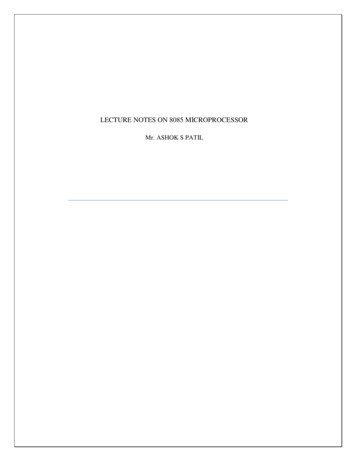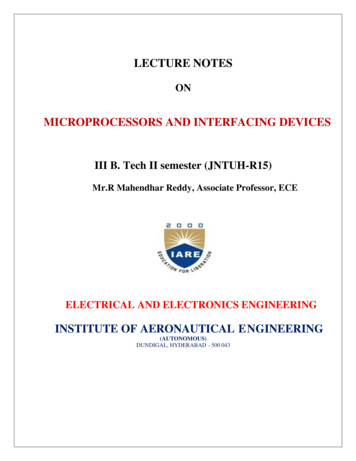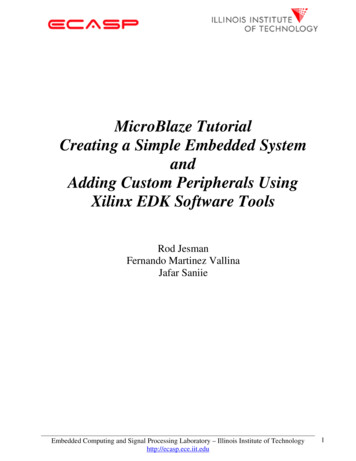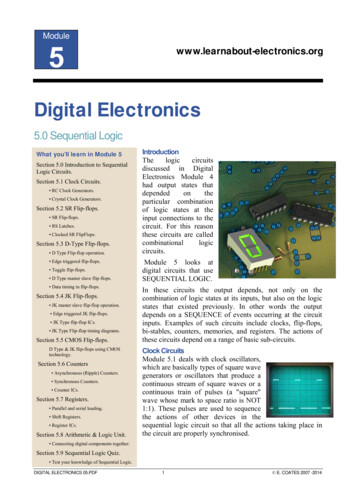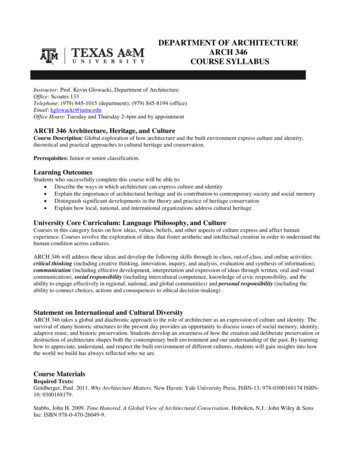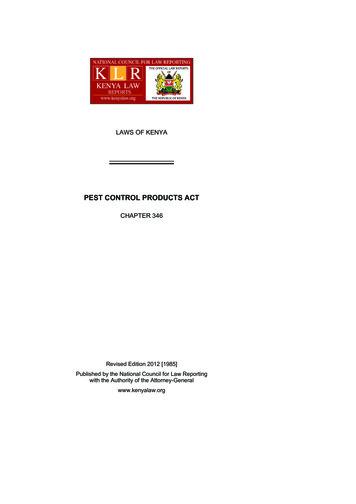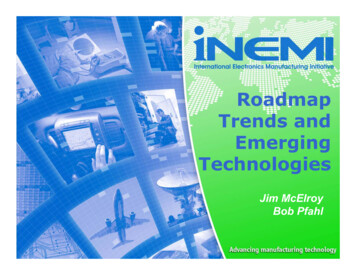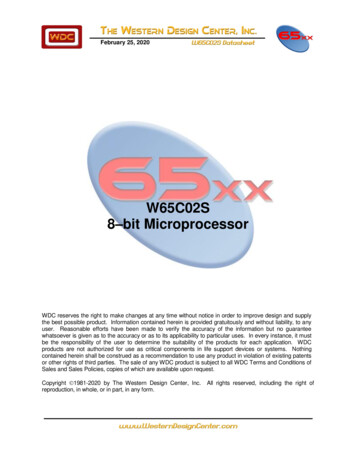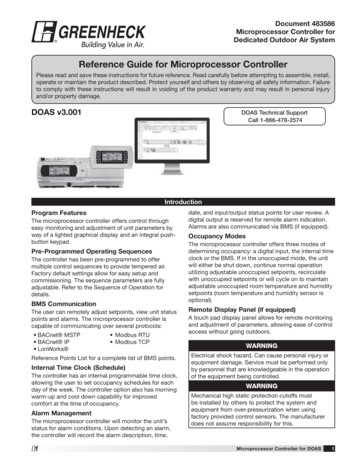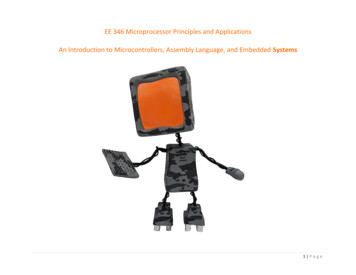
Transcription
EE 346 Microprocessor Principles and ApplicationsAn Introduction to Microcontrollers, Assembly Language, and Embedded Systems1 P a g e
An Introduction to Microcontrollers, Assembly Language, and Embedded SystemsREADINGThe AVR Microcontroller and Embedded Systems using Assembly and C) by Muhammad Ali Mazidi, Sarmad Naimi, and Sepehr NaimiChapter 0: Introduction To ComputingSection 0.1: Number Systems and Appendix A “Number Systems” at the end of this documentSection 0.2: Digital PrimerChapter 1: The AVR Microcontroller: History and FeaturesSection 1.1: Microcontrollers and Embedded ProcessorsChapter 2: AVR Architecture and Assembly Language ProgrammingSection 2.5: AVR Data Format and DirectivesSection 2.6: Introduction to AVR Assembly ProgrammingSection 2.7: Assembling An AVR Program2 P a g e
An Introduction to Microcontrollers, Assembly Language, and Embedded SystemsCONTENTSReading . 2What is an Embedded System? . 4The Building Blocks of an Embedded System. 5What is an Arduino? . 6What is 3DoT? . 7What is The 3DoT Maze Kit? . 8What is a Program? . 9How is Machine Code Related to Assembly Language?. 10Anatomy of an Assembly Instruction . 11Design Example . 12Development Steps . 13Help . 143 P a g e
An Introduction to Microcontrollers, Assembly Language, and Embedded SystemsWHAT IS AN EMBEDDED SYSTEM? An embedded system is an electronic systemthat contains at least one controlling device,i.e. “the brain”, but in such a way that it ishidden from the end user. That is, thecontroller is embedded so far in the systemthat usually users don’t realize its presence. Embedded systems perform a dedicatedfunction.What is the Controlling Device?EE CourseTechnologyToolsEE201Discrete LogicBoolean AlgebraEE301Field Programmable Gate Array (FPGA),Application-Specific Integrated Circuit (ASIC)HDL (typically VHDL or Verilog)EE346MicrocontrollerProgram (typically C or Assembly)EE443System on a Chip (SoC)System Level Design Language4 P a g e
An Introduction to Microcontrollers, Assembly Language, and Embedded SystemsTHE BUILDING BLOCKS OF AN EMBEDDED SYSTEM“This course will be an introduction to modern RISC based microcontrollers and assembly language programming.We will use the Atmel AVR family of microcontrollers to teach hardware design of small, minimum-componentsystems performing simple task-oriented activities.” Source: EE346 Syllabus5 P a g e
An Introduction to Microcontrollers, Assembly Language, and Embedded SystemsWHAT IS AN ARDUINO? Arduino is an open-source electronics PCB containing a microcontroller and the things needed to support it: Power Supply,Communications, Reset Button, Clock, and Connectors for adding Sensors and Actuators in the physical world. Using an Arduino you can develop interactive objects, taking inputs from a variety ofswitches or sensors, and controlling a variety of lights, motors, and other physical outputs. The Arduino consists of two parts; the hardware and the software.o Our Robot Board is based on the Arduino Leonardo which contains an ATmega32U48 bit microcontroller.o We will be using AVR Studio to develop the software for the Arduino in place of theArduino IDE and associated Scripting Language.6 P a g e
WHAT IS 3DOT3DoT (The 3D of Things) is a micro-footprint 3.5 x 7 cm all-in-one Arduino compatible microcontroller boarddesigned for robot projects by Humans for Robots. Microcontroller: ATmega32U4Bluetooth: FCC-certified BLE 5.0 modulePower Management: RCR123A battery holder Included 600 mAh rechargeable battery Microchip MCP7383 battery charge controllerExternal battery connector – for input voltagesbetween 4 – 18 V Motors & Servos: 2x JST motor connectors 2x standard servo connectorsExpansion: 16-pin top female headers for shields – providing I/O, I²C, SPI, USART, 3.3 V and 5 V. Reverse polarity protection – plug in thebattery backwards? No problemForward-facing 8-pin female header for sensor shields – providing 4 analog pins, I²C, and 3.3 V power– for sensor shields like infrared or metal-detecting shields. Great location for headlights, lasers,ultrasonics, etc.Programming switch: Three-position switch for easy programming No more double-tapping a button and rushing to program your board, or your robot trying to driveaway while programming. Set the switch to PRG to program, RUN to execute your code.7 P a g e
WHAT IS THE 3DOT MAZE KIT?Designed by Humans for Robots for CSULB EE Digital Design and Project courses, the 3DoT MazeKit includes almost everything needed tocomplete the Labs.K IT C ONTENTS 3DoT PaperBot Chassiso 3DoT Board v10.1o Bluetooth LE moduleo Wood Chassiso Drivetrain (motors, wheels,caster) IR Sensor Shield (soldered) Wheel Rotary Encoder Shield 3x4 ft Maze (Back/White, Colorbased on cost)N OT INCLUDED PaperBot Template (Free Download) USB-B cable Playing Cards (Free Download)8 P a g e
WHAT IS A PROGRAM? The Program is a “very specific list of instructions” to the computer. The process of “creating the program” is where much of an electrical engineer’s time is spent. The program is often referred to asSoftware, while the physical systemcomponents are called Hardware. Softwareheld within non-volatile memory is calledFirmware. Software design is all about creatingpatterns of 0’s and 1’s in order to get thecomputer to do what we want. These 0'sand 1's are known as Machine Code.0010 0111 0000 0000 1110 1111 0001 1111 1011 1001 0000 0111 1011 1001 0001 10001011 1001 0000 0100 1011 0000 0111 0110 1011 1000 0111 0101 1100 1111 1111 1101 The architecture of the processer (or computer) within a microcontroller is unique as are the Machine CodeInstructions it understands.0010 0111 0000 00001110 1111 0001 1111 The list of Machine Code Instructions understood by a Microcontroller is known as the Machine Language.9 P a g e
HOW IS MACHINE CODE RELATED TO ASSEMBLY LANGUAGE?Machine Code (The language of the machine) Binary Code (bit sequence) that directs the computer to carryout (execute) a pre-defined 000000010000111101111000Assembly Language A computer language where there is a one-to-onecorrespondence between a symbolic (assembly languageinstruction) and a machine code instruction. The language of the machine in human readable formclrseroutoutr16r17DDRC, r16PORTC, r17Corollary Specific to a single computer or class of computers (non-portable)10 P a g e
ANATOMY OF AN ASSEMBLY INSTRUCTIONSample Code SegmentMachine CodeBinary0010 0111 00001110 1111 00011011 1001 00001011 1001 0001Assembly seroutoutr16r17DDRC, r16PORTC, r17 The Operation Code or Opcode for short, is a mnemonic that tells the CPU what instruction is to beexecuted. In the sample code above that would be clr (clear), ser (set register), and out (output toI/O location). One or more operands follow the Opcode. The Operand(s) specify the location of the data that is to be operated on by the CPU. In many cases it isthe Arithmetic Logic Unit (ALU) that performs the specified operation.11 P a g e
DESIGN EXAMPLEWrite an Assembly Program to turn a light on and off with a switch. A similar program was used inthe design of The Wake-up Machine.12 P a g e
DEVELOPMENT STEPS13 P a g e
HELP0010 0111 0000 0000 2 2700 16 clr r16.An Important part of this course is understanding the Design and Language of "The Computer."The computer implements the classical digital gate you learned in your Digital Logic class (EE201) in software withinstructions like and, or, and eor.You are also going to have to seamlessly move from binary to hexadecimal and back again (i.e., Number Systems).Computer programs move data through Registers, so a working knowledge of Flip-Flops and Registers is also animportant foundational part of this class.Finally, instead of designing with gates (EE201) you will be designing with code. So you will need to reviewProgramming concepts like: data transfer (assignment expressions) , arithmetic and logic operators, controltransfer (branching and looping), and bit and bit test operators that you leaned in your programming class(CECS174 or CECS100).The good news is that help is available in Chapter 0: “Introduction to Computing” of your textbook, thesupplemental reading provided at the beginning of this document, the web, and Appendix A - Number Systems.14 P a g e
APPENDIX A – NUMBER SYSTEMSNumbers and Their Computer RepresentationINTRODUCTIONBase 10 result of ten fingersArabic symbols 0-9, India created Zero and Positional NotationOther Systems: Roman Numerals: essentially additive, Importance of Roman Numeral lies in whether a symbol precedes or follows anothersymbol. Ex. IV 4 versus VI 6. This was a very clumsy system for arithmetic operations.POSITIONAL NOTATION (POSITIVE REAL INTEGERS)Fractional numbers will not be considered but it should be noted that the addition of said would be a simple and logical addition to the theory presented.The value of each digit is determined by its position. Note pronunciation of 256 “Two Hundred and Fifty Six?Ex. 256 2*102 5*101 6*100Generalization to any base or radixBase or Radix Number of different digit which can occur in each position in the number system.N Anrn An-1rn-1 A1r1 A0r0 (or simple A1r A0)INTRODUCTION TO BINARY SYSTEMThe operation of most digital devices is binary by nature, either they are on or off.Examples: Switch, Relay, Tube, Transistor, and TTL ICThus it is only logical for a digital computer to in base 2.Note: Future devices may not have this characteristic, and this is one of the reasons the basics and theory are important. For they add flexibilityto the system.In the Binary system there are only 2 states allowed; 0 and 1 (FALSE or TRUE, OFF or ON)15 P a g e
Example:Most Significant Bit High Order Bit1010 1*23 0*22 1*21 0*20 1010 Least Significant BitLow Order Bit Denotes Base 10Usually implied by contextBit One Binary Digit (0 or 1)This positional related equation also gives us a tool for converting from a given radix to base 10 - in this example Binary to Decimal.BASE EIGHT AND BASE SIXTEENEarly in the development of the digital computer Von Neuman realized the usefulness of operating in intermediate base systems such as base8 (or Octal)By grouping 3 binary digits or bits one octal digit is formed. Note that 23 8Binary to Octal Conversion Table222120000 001 010 011 100 101 110 111 01234567Example:Symbols (not numbers) 8 and 9 are not used in octal.100 001 010 1104 126 8 4*83 1*82 2*81 6*80 2134This is another effective way of going from base 2 to base 10Summary: Base 8 allows you to work in the language of the computer without dealing with large numbers of ones and zeros. This is madepossible through the simplicity of conversion from base 8 to base 2 and back again.In microcomputers groupings of 4 bits (as opposed to 3 bits) or base 16 (24) is used. Originally pronounced Sexadecimal, base 16 was quicklyrenamed Hexadecimal (this really should be base 6).16 P a g e
Binary to Hex Conversion Table232221200000 0001 0010 0011 0100 0101 0110 0111 1000 1001 1010 1011 1100 1101 1110 1111 0123456789ABCDEFIn Hex Symbols for 10 to 15 are borrowed from the alphabet. This shows how relative numbers really are or in other words, they truly are justsymbols.Example:1000 0101 0110856 16 8*162 5*161 6*160 2134It is not as hard to work in base 16 as you might think, although it does take a little practice.CONVERSION FROM BASE 10 TO A GIVEN RADIX (OR BASE)Successive Division is best demonstrated by an example2222224321105210\\\\\\1 Least Significant Bit10101 Most Significant BitTo get the digits in the right order let them fall to the right.For this example: 4310 1010112Quick Check (Octal) 101 011 5*8 3 431017 P a g e
Another example: Convert 4310 from decimal to Octal884350\\35 Most Significant BitFor this example: 4310 538Quick Check (Octal) 5*8 3 4310GENERALIZATION OF THE PROCEDURE OR WHY IT WORKSrrrrNN1N2N3rrNn-1Nn0\\\\A0A1A2A3Least Significant Bit\\An-1AnMost Significant BitWhere r radix, N number, A remainder, and n the number of digits in radix r for number N. Division is normally done in base 10.Another way of expressing the above table is:N r*N1 A0N1 r*N2 A1N2 r*N3 A2 Nn-1 r*Nn An-1Nn r*0 Anor (now for the slight of hand)N r*( r*N2 A1) A0substitute N1N r2N2 rA1 A0multiply r through equationN r2(r*N3 A2) rA1 A0substitute N2 N Anrn An-1rn-1 A1r1 A0r0 18 P a g e
NOMENCLATUREBitByteNibbleWord 1 binary digit8 bitsone half byte 4 bitsComputer DependentBinary ArithmeticBINARY ADDITIONBinary addition is performed similar to decimal addition using the following binary addition rules:0 0 00 1 11 0 11 1 10(0 with a carry of 1)Examples:Problem 2110 1010 31104510 5410 9910101012 010102111112Check 310 710 10101011012 1101102110001120112 1112101021*23 0*22 1*21 0*201*8 0*4 1*2 0*1 101019 P a g e
OCTAL ADDITIONOctal addition is also performed similar to decimal addition except that each digit has a range of 0 to 7 instead of 0 to 9.Problem 2110 1010 31104510 5410 9910310 710 101025855838 128 378Check 668 7814381283*81 7*801*82 4*81 3*801*81 2*803*8 7*1 311064 32 3 99108 2 1010HEXADECIMAL ADDITIONHex addition is also performed similar to decimal addition except that each digit has a range of 0 to 15 instead of 0 to 9.Problem 2110 1010 31104510 5410 9910310 710 101015162D16316 0A161F16Check 3616 7166316A16 (not 10)1*161 15*1606*161 3*16010*16016 15 311096 3 9910101020 P a g e
BINARY 4310x 1101210112000021011210112100011112Check 8*161 15*160128 15 14310BINARY 100121011101011011010001012Check 1*161 5*16016 5 2110Practice arithmetic operations by making problems up and then checking your answers by converting them back to base 10 via different bases(i.e., 2, 8, and 16).21 P a g e
How a computer performs arithmetic operations is a much more involved subject and has not been dealt with in this section.COMPLEMENTS AND NEGATIVE NUMBERS OR ADDING A SIGN BITAddition, Multiplication, and Division is nice but what about subtraction and negative numbers? From grade school you have learned thatsubtraction is simply the addition of a negative number. Mathematicians along with engineers have exploited this principle along with moduloarithmetic — a natural outgrowth of adders of finite width — to allow computers to operate on negative numbers without adding any newhardware elements to the arithmetic logic unit (ALU).SIGN MAGNITUDEHere is a simple solution, just add a sign bit. To implement this solution in hardware you will need to create a subtractor; which means moremoney.signmagnitudeExample:-2 100102ONES COMPLEMENTHere is a solution that is a little more complex. Add the sign bit and invert each bit making up the magnitude — simply change the 1’s to 0’s andthe 0’s to 1’s.signmagnitudeExample:-2 111012To subtract in 1’s complement you simply add the sign and magnitude bits letting the last carry bit (from the sign) fall into the bit bucket, andthen add 1 to the answer. Once again let the last carry bit fall into the bit bucket. The bit bucket is possible due to the physical size of the adder.0 10102 1 110120 10002 1210 (-2)8Adjustment0 10012Although you can now use your hardware adder to subtract numbers, you now need to add 1 to the answer. This again means adding hardware.Compounding this problem, ones complement allows two numbers to equal 0 (schizophrenic zero).22 P a g e
TWOS COMPLEMENTHere is a solution that is a little more complex to set up, but needs no adjustments at the end of the addition. There are two ways to take thetwos complement of a number.Method 1 Take the 1’s complement and add 10 00102 1 11012 12 start21’s complement (i.e. invert)add 11 11102Method 2 Move from right to left until a 1 is encountered then invert.0 00102start 21002no change102no change but one is encountered1102invert change 0 to 111102invert change 0 to 11 11102invert change 0 to 1Subtraction in twos complement is the same as addition. No adjustment is needed, and twos complement has no schizophrenic zero althoughit does have an additional negative number (see How It Works). 0 10102101 11102 (-2)0 10012823 P a g e
Examples:Problem 3310 - 1910 14106910 - 8410 -15100 10000120 10001012 1 10110120 0011102Check convert tointermediate baseE16 1410 1 010110021 11100012convert back to sign magnitude- 00011112convert to intermediate base (16)- F16 - 1510WHY IT WORKSReal adders have a finite number of bits, which leads naturally to modulo arithmetic — the bit bucket.OVERFLOWWith arithmetic now reduced to going around in circles, positive numbers can add up to negative and vice-versa. Two tests provide a quickcheck on whether or not an “Overflow” condition exists.Test 1 If the two numbers are negative and the answer is positive, an overflow has occurred.Test 2 If the two number are positive and the answer is negative, an overflow has occurred.24 P a g e
If computers were calculators and the world was a perfect place, we would be done. But they are not and so we continue by looking at a few real worldproblems and their solutions.CHARACTER CODES OR NON-NUMERIC INFORMATIONDECIMAL NUMBER PROBLEMRepresent a Decimal Numbers in a Binary Computer. A binary representation of a decimal number, a few years ago, might have been “hardwired” into the arithmetic logic unit (ALU) of the computer. Today it, more likely than not, is simply representing some information that is naturallyrepresented in base 10, for example your student ID.SOLUTIONIn this problem, ten different digits need to be represented. Using 4 bits 24 or 16 combinations can be created. Using 3 bits 23 or 8 combinationscan be created. Thus 4 bits will be required to represent one Decimal Digit. It should here be pointed out how 16 combinations can be createdfrom 4 bits (0000 - 1111) while the largest numeric value that can be represented is 15. The reason that the highest numeric value and thenumber of combinations are different, is due to zero (0) being one of the combinations. This difference points up the need to always keep trackof wetter or not you are working zero or one relative and what exactly you are after — a binary number or combinations.The most common way of representing a decimal number is named Binary Coded Decimal (BCD). Here each binary number corresponds toits decimal equivalent, with numbers larger than 9 simply not allowed. BCD is also known as an 8-4-2-1 code since each number represents therespective weights of the binary digits. In contrast the Excess-3 code is an unweighted code used in earlier computers. Its code assignmentcomes from the corresponding BCD code plus 3. The Excess-3 code had the advantage that by complementing each digit of the binary coderepresentation of a decimal digit (1’s complement), the 9’s complement of that digit would be formed. The following table lists each decimal digitand its BCD and Excess-3 code equivalent representation. I have also included the negative equivalent of each decimal digit encoded using theExcess-3 code. For instance, the complement of 0100 (1 decimal) is 1011, which is 8 decimal. You can find more decimal codes on page 18 of“Digital Design” by M. Morris Mano (course text).Binary CodedDecimal 0101125 P a g e
0101000011001000010000ALPHANUMERIC CHARACTER PROBLEMRepresent Alphanumeric data (lower and upper case letters of the alphabet (a-z, A-Z), digital numbers (0-9), and special symbols (carriagereturn, line feed, period, etc.).SOLUTIONTo represent the upper and lower case letters of the alphabet, plus ten numbers, you need at least 62 (2x26 10) unique combinations.Although a code using only six binary digits providing 26 or 64 unique combinations would work, only 2 combinations would be left for specialsymbols. On the other hand a code using 7 bits provides 27 or 128 combinations, which provides more than enough room for the alphabet,numbers, and special symbols. So who decides which binary combinations correspond to what character. Here there is no “best way.” Aboutthirty years ago IBM came out with a new series of computers which used 8 bits to store one character (28 256 combinations), and devisedthe Extended Binary-Coded Decimal Interchange Code (EBCDIC pronounced ep-su-dec) for this purpose. Since IBM had a near monopolyon the computer field, at that time, the other computer makers refused to adopt EBCDIC, and that is how the 7bit American Standard Code forInformation Interchange (ASCII) came into existence. ASCII has now been adopted by virtually all micro-computer and mini-computermanufacturers. The table below shows a partial list of the ASCII code. Page 23 of the text lists all 128 codes with explanations of the 383940202122232425262728!“# H26 P a g e
2B2C2D2E2F303132333435363738393A3B3C3D3E3F)* ,*/0123456789:; PQRSTUVWXYZ[\] The word “string” is commonly used to describe a sequence of characters stored via their numeric codes — like ASCII).Although ASCII requires only 7 bits, the standard in computers is to use 8 bits, where the leftmost bit is set to 0. This allows you to codeanother 128 characters (including such things as Greek letters), giving you an extended character set, simply by letting the leftmost bit be a 1.This can also lead to a computer version of the tower of Babel. Alternatively, the leftmost bit can be used for detecting errors when transmittingcharacters over a telephone line. Which brings us to our next problem.SYNTHESISAlthough ASCII solves the communication problem between English speaking computers, what about Japanese, Chinese, or Russiancomputers which have different, and in all these examples, larger alphabets?COMMUNICATION PROBLEMBinary information may be transmitted serially (one bit at a time) through some form of communication medium such as a telephone line or aradio wave. Any external noise introduced into the medium can change bit values from 1 to 0 or visa versa.27 P a g e
SOLUTIONThe simplest and most common solution to the communication problem involves adding a parity bit to the information being sent. The functionof the parity bit is to make the total number of 1’s being sent either odd (odd parity) or even (even parity). Thus, if any odd number of 1’s weresent but an even number of 1’s received, you know an error has occurred. The table below illustrates the appropriate parity bit (odd and even)that would be appended to a 4-bit chunk of data.SYNTHESISWhat happens if two binary digits change bit values? Can a system be devised to not only detect errors but to identify and correct the bit(s) thathave changed? One of the most common error-correcting codes was developed by R.W. Hamming. His solution, known as a Hamming code,can be found in a very diverse set of places from a Random Access Memory (RAM) circuit to a Spacecraft telecommunications link. For moreof error correcting codes read pages 299 to 302 of the text.Although detecting errors is nice, preventing them from occurring is even better. Which of course brings us to our next problem.SHAFT ENCODER PROBLEMAs a shaft turns, you need to convert its radial position into a binary coded digital number.SOLUTIONThe type of coder which will be briefly described below converts a shaft position to a binary-coded digital number. A number of different typesof devices will perform this conversion; the type described is representative of the devices now in use, and it should be realized that morecomplicated coders may yield additional accuracy. Also, it is generally possible to convert a physical position into an electric analog-type signaland then convert this signal to a digital system. In general, though, more direct and accurate coders can be constructed by eliminating theintermediate step of converting a physical position to an analog electric signal. The Figure below illustrates a coded-segment disk which iscoupled to the shaft.28 P a g e
The shaft encoder can be physically realized using electro-mechanical (brush) or electro-optical technology. Assuming an electro-opticalsolution, the coder disk is constructed with bands divided into transparent segments (the shaded areas) and opaque segments (the unshadedareas). A light source is put on one side of the disk, and a set of four photoelectric cells on the other side, arranged so that one cell is behindeach band of the coder disk. If a transparent segment is between the light source and a light-sensitive cell, a 1 output will result; and if an opaquearea is in front of the photoelectric cell, there will be a O output.There is one basic difficulty with the coder illustrated: if the disk is in a position where the output number is changing from 011 to 100, or in anyposition where several bits are changing value, the output signal may become ambiguous. As with any physically realized device, no matterhow carefully it is made, the coder will have erroneous outputs in several positions. If this occurs when 011 is changing to 100, several errorsare possible; the value may be read as 111 or 000, either of which is a value with considerable errors. To circumvent this difficulty, engineersuse a "Gray," or "unit distance," code to form the coder disk (see previous Figure). In this code, 2 bits never change value in successive codedbinary numbers. Using a Gray coded disk, a 6 may be read as 7, or a 4 as 5, but larger errors will not be made. The Table below shows a listingof a 4-bit Gray code.Decimal0123456789101112131415Gray 101010101110011000SYNTHESISGray code is used in a multitude of application other than shaft encoders. For example, CMOS circuits draw the most current when they areswitching. If a large number of circuits switch at the same time unwelcome phenomena such as “Ground Bounce” and “EMI Noise” can result.If the transistors are switching due to some sequential phenomena (like counting), then these unwelcome visitors can be minimized by replacinga weighted binary code by a Gray code.29 P a g e
If the inputs to a binary machine are from an encoder using a Gray code, each word must be converted to conventional binary or binary-codeddecimal bit equivalent. How can this be done? Before you can answer this question, you will need to learn about Boolean Algebra — what acoincidence, that’s the topic of the next Section.30 P a g e
APPENDIX B – ATMEGA INSTRUCTION SET11Source: ATmega328P Data Sheet http://www.atmel.com/dyn/resources/prod documents/8161S.pdf Chapter 31 Instruction Set Summary31 P a g e
32 P a g e
33 P a g e
The AVR Microcontroller and Embedded Systems using Assembly and C) by Muhammad Ali Mazidi, Sarmad Naimi, and Sepehr Naimi Chapter 0: Introduction To Computing Section 0.1: Number Systems and Appendix A "Number Systems" at the end of this document Section 0.2: Digital Primer Chapter 1: The AVR Microcontroller: History and Features

